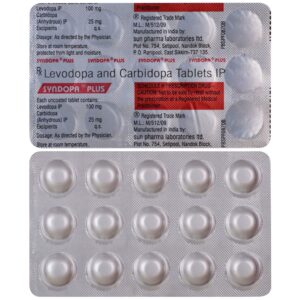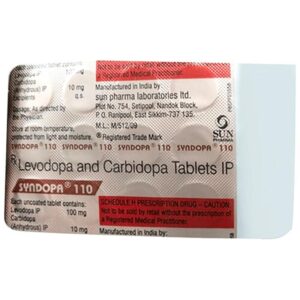LEVODOPA + CARBIDOPA
Levodopa: Levodopa, also known as L-DOPA, is a medication used primarily in the treatment of Parkinson’s disease. It is a precursor to dopamine, a neurotransmitter that is lacking in individuals with Parkinson’s disease.
The mechanism of action of Levodopa involves crossing the blood-brain barrier and being converted into dopamine in the brain. Dopamine is then used to replenish the depleted levels in Parkinson’s patients, helping to alleviate their symptoms such as tremors, stiffness, and difficulty with movement.
The dosage of Levodopa varies depending on the individual’s condition, age, and response to the medication. It is typically taken orally, either alone or in combination with other medications such as carbidopa, which helps enhance its effectiveness. The dose is typically started low and gradually increased under medical supervision until the optimal dose is achieved.
Like any medication, Levodopa can have side effects. Common side effects include nausea, vomiting, dizziness, loss of appetite, and insomnia. Some individuals may experience dyskinesias, which are involuntary muscle movements. These side effects can be mitigated by adjusting the dosage or adding other medications to the treatment regimen, but it is essential to consult with a healthcare professional for proper management.
Over time, some people may experience wearing-off periods, where the effectiveness of Levodopa diminishes before the next dose. This phenomenon is known as “wearing off” and may require adjustments in medication timing or the addition of other medications to manage.
It is important to note that Levodopa may interact with other medications or substances, so it is crucial to inform the healthcare provider about all current medications and medical conditions prior to starting treatment. They will be able to assess the appropriate dose, potential interactions, and provide necessary guidance and monitoring throughout the course of therapy.
Carbidopa: Carbidopa is a medication used in combination with levodopa to treat the symptoms of Parkinson’s disease and Parkinsonism-like symptoms caused by certain medications. It is available in tablet and extended-release tablet form.
The primary use of carbidopa is to enhance the effectiveness of levodopa. Levodopa is the precursor to dopamine and is converted to dopamine in the brain, which helps alleviate the motor symptoms of Parkinson’s disease. However, levodopa has a significant disadvantage – a large portion of it gets metabolized into dopamine before it reaches the brain, leading to side effects. This is where carbidopa comes in.
Carbidopa works by inhibiting an enzyme called DOPA decarboxylase, which converts levodopa into dopamine outside the brain. By blocking this enzyme in the periphery, carbidopa allows more levodopa to reach the brain, leading to better control of symptoms.
The typical dose of carbidopa varies depending on the individual’s needs. It is usually started at a low dose and gradually increased until the desired effect is reached. The dose typically ranges from 25-75 mg per day. The extended-release tablets are taken once or twice daily, usually with food.
As with any medication, carbidopa can cause side effects. Common side effects include dizziness, lightheadedness, nausea, vomiting, loss of appetite, dry mouth, drowsiness, and headache. These side effects are usually mild and improve with time.
Rare but more severe side effects can include mood or mental changes, hallucinations, uncontrolled movements, muscle twitching, severe stomach pain, and signs of allergic reactions such as rash, itching, swelling, or difficulty breathing. If any of these side effects occur, it is essential to seek immediate medical attention.
Carbidopa can interact with other medications, so it is crucial to inform your healthcare provider about all the medications you are taking, including over-the-counter drugs and supplements.
Overall, carbidopa plays a vital role in improving levodopa’s effectiveness and is an essential component of Parkinson’s disease treatment. However, it is essential to work closely with a healthcare professional to determine the appropriate dose and monitor for any potential side effects.


